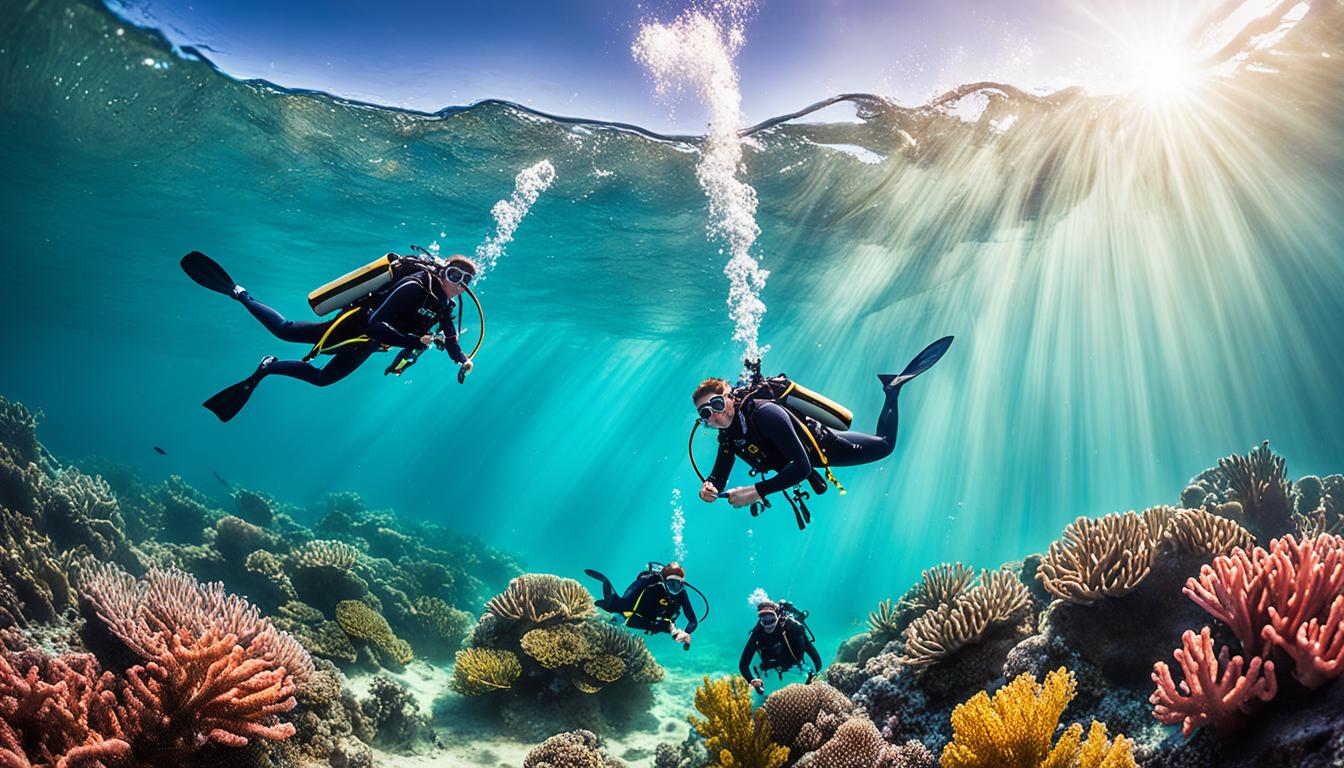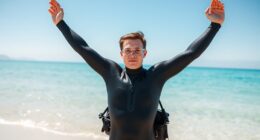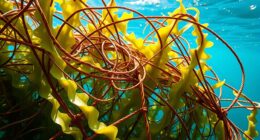Dive into adventure with a spearfishing course designed to hone your skills and immerse you in underwater thrills. Whether you’re a beginner or an experienced diver, a spearfishing course offers the opportunity to learn essential techniques, increase your knowledge of the marine environment, and enhance your spearfishing abilities. With expert instructors and comprehensive training, you can unlock the secrets of the ocean and take your spearfishing journey to new depths.
Imagine this: You find yourself floating weightlessly in the vibrant blue waters, the sun’s gentle rays piercing through the surface above. The excitement is palpable as you adjust your mask and take a deep breath. You dive down, silently descending into the vast abyss, leaving the world of humans behind. The silence envelops you, and a sense of serenity washes over your entire being.
You are no longer just an observer; you have become a part of this incredible underwater world. The allure of deep spearfishing lies in the silence, vastness, and challenge it offers to spearfishers. As you venture deeper into the ocean, you enter a realm teeming with life, where the waters house a diverse array of species that are more elusive and challenging to spear. It is a thrilling and awe-inspiring experience.
To embark on this grand adventure, you must equip yourself with the necessary skills and knowledge. Freediving is essential for deep spearfishing, requiring rigorous training, exceptional breath control, and understanding of your physical and mental capabilities. It is through these preparations that you will be able to explore the mysteries of the ocean and unlock its secrets.
However, deep spearfishing does come with its risks. Shallow water blackout, barotrauma, and encounters with predatory species are a few of the dangers that spearfishers may face. That’s why it’s crucial to be an adept swimmer, possess excellent breath-hold capabilities, and be familiar with your equipment and its limitations. Additionally, taking courses in freediving physiology, rescue techniques, and emergency first aid is highly recommended to handle unexpected situations with confidence.
Deep spearfishing is not just about the thrill of the hunt; it’s about responsible fishing practices and conservation. Ethical spearfishers practice selective fishing, taking only what they need and adhering to conservation regulations. By preserving the delicate balance of marine ecosystems, we ensure that future generations can also experience the wonders of the underwater world.
Are you ready to embark on a deep spearfishing adventure? Lancaster Scuba offers a curated selection of scuba and spearfishing equipment to suit your needs. Whether you’re a beginner or an experienced spearfisher, their range of high-quality gear will help enhance your underwater experiences.
So, whether you choose to start your spearfishing journey with shore diving or venture out on a boat, the ocean awaits you. Prepare yourself, seize the opportunity, and unlock the ocean’s secrets with a spearfishing course that will take you on a thrilling underwater odyssey.
Key Takeaways:
- Deep spearfishing requires physical prowess and a deep understanding of the ocean’s mysteries.
- The allure of deep spearfishing lies in the silence, vastness, and challenge it offers to spearfishers.
- Freediving is essential, requiring rigorous training, exceptional breath control, and knowledge of physical and mental capabilities.
- Spearfishers must be adept swimmers, have excellent breath-hold capabilities, and be familiar with their equipment and its limitations.
- Taking courses in freediving physiology, rescue techniques, and emergency first aid is recommended for spearfishers.
The Essence of Spearfishing
Spearfishing is an ancient practice that combines the essence of hunting fish with the mesmerizing beauty of the underwater world. It is a sport that has evolved over centuries, preserving the traditions of ancient techniques while embracing the advancements of modern technology.
Spearfishing allows divers to immerse themselves in the silent dance beneath the waves, where skill, patience, and respect for the underwater world are paramount. With a spear, speargun, or polespear in hand, spearfishers test their abilities and connect deeply with the marine environment and its inhabitants.
Spearfishing is not just about the thrill of the hunt; it goes beyond that. It is a sustainable fishing method that champions selective hunting, preserving the delicate balance of marine ecosystems. Spearfishers engage in ocean cleanup activities and take part in coral reef restoration projects, actively contributing to marine conservation efforts.
The sport has transcended borders and become popular in various spearfishing destinations, including Hawaii and the Mediterranean Sea. Spearfishing enthusiasts document their underwater experiences through photography, preserving memories and sharing the captivating beauty of the underwater world with others.
Mastering underwater lighting techniques is crucial for effective spearfishing photography, capturing the essence of the underwater world and promoting awareness about marine conservation efforts. Spearfishing photographers play a vital role in raising awareness and inspiring others to protect our oceans.
Historical data reveals that spearfishing has transformed from a means of sustenance in ancient civilizations to a sport deeply rooted in tradition. However, it has also embraced modern technology for greater efficiency and sustainability. Spearfishing communities emphasize selective fishing methods, targeting specific species to reduce overfishing and minimize bycatch commonly associated with commercial fishing.
Spearfishers prioritize the knowledge of marine biology and ecology, studying the species they target to understand their role in the ecosystem and their population status. This fosters sustainable fishing practices and ensures the responsible interaction of spearfishers with the marine environment.
Equipment plays a crucial role in spearfishing success. Spearguns, wetsuits, and weight belts are essential gear for divers to navigate the underwater world and enhance their hunting capabilities. Spearfishers maintain their spearguns meticulously to ensure reliability and optimal performance underwater.
Techniques like stalking and ambush hunting require skill, patience, and a deep understanding of underwater hunting techniques. Spearfishers employ these strategies to approach and target fish effectively, ensuring successful catches while minimizing unnecessary disturbance to the marine environment.
Environmental awareness is paramount in spearfishing. Spearfishers actively participate in sustainable fishing practices, engaging in beach cleanups, and supporting marine conservation initiatives. The spearfishing community thrives on building a network of like-minded individuals who share knowledge, experiences, and resources, fostering a culture of conservation, camaraderie, and support within the sport.
Historical Overview
Spearfishing has a rich historical tradition, dating back thousands of years and representing one of the oldest forms of fishing practiced by early humans. In ancient times, divers would rely on their skill and primitive tools, such as sharpened sticks, to catch fish in shallow waters.
As technology advanced, spearfishing underwent significant changes. The invention of tools like spearguns and diving equipment allowed divers to explore deeper waters and pursue a wider variety of marine life. Historical references even show the use of freedivers in ancient warfare, highlighting their strategic value in naval operations, such as scouting enemy harbors and cutting anchor cables of attacking ships.
One notable milestone in the history of spearfishing is the tradition of ama divers in Japan around 2,000 years ago. These courageous divers began collecting pearls, showcasing the long-standing relationship between freediving and the pursuit of valuable resources.

In more recent history, Dottie Frazier made her mark on the sport in the United States in 1940 by pioneering freediving for women. This significant milestone opened the doors for female participation in freediving, expanding the community and promoting gender equality.
Today, with advancements in technology and a deeper understanding of marine behavior, spearfishing has evolved into modern spearfishing. Freedivers now have access to a range of equipment and techniques that enhance their ability to explore the underwater world and connect with the ocean in a unique way.
Equipment and Techniques
When it comes to spearfishing, having the right equipment and mastering the necessary techniques is crucial for success. Let’s explore the essential gear you’ll need and the techniques you’ll need to perfect.
Spearfishing Equipment
The spearfishing equipment consists of several key items that are essential for a safe and productive dive. The primary tool used in spearfishing is a speargun, which comes in various types depending on your skill level and target species. Spearguns use elastic power or compressed air to launch a spear accurately at the fish you’re targeting.
In addition to a speargun, divers rely on other equipment to enhance their underwater experience. A quality snorkel allows you to breathe comfortably while floating on the surface, while a well-fitted pair of fins helps you move efficiently through the water. A wetsuit not only provides thermal protection but also allows you to blend in with your surroundings and get closer to fish without startling them.
Spearfishing Techniques
Mastering the right techniques is what separates successful spearfishers from the rest. Moving quietly underwater is essential to avoid alerting fish and maximize your chances of getting close enough for a shot. By conserving oxygen through controlled and efficient breathing, you can extend your dive time and stay underwater longer.
When it comes to actually targeting and spearing fish, precision is key. Aim for the vital areas and strive for clean kills to minimize suffering and ensure a humane harvest. It’s essential to practice your aim and develop the necessary skills to strike with accuracy.

“The course is designed to teach you not only the technical aspects of spearfishing but also the important ethical considerations and conservation practices.” – Cameron Kirkconnell, FII Spearfishing Course Developer
As you can see, spearfishing is a multifaceted activity that requires the right gear and a solid understanding of the techniques involved. By investing time in developing your skills and using top-quality equipment like those available at Spear America, you’ll be well on your way to becoming a skilled and responsible spearfisher.
Purchasing from Spear America offers additional benefits beyond just obtaining the necessary gear. Students can enjoy exclusive discounts, professional gear fitting, and support a local business. By supporting Spear America, you’re also contributing to the local community and dive club, helping to foster a vibrant spearfishing culture.
Safety and Conservation
When it comes to spearfishing, safety should always be a top priority. Understanding the risks involved and diving within your limits is crucial to ensure a positive and accident-free experience. By following best practices and participating in proper training, you can minimize potential dangers and enjoy this thrilling activity responsibly.
One of the key aspects of spearfishing safety is education. Enrolling in a reputable spearfishing course, such as the Evolution Spearfishing Instructor Course, can provide you with the knowledge and skills needed to navigate the marine environment safely. This comprehensive course covers various components, including spearfishing theory, rigging & knot tying, open water diving, and more. It is designed to equip you with the necessary tools to dive with confidence and reduce the likelihood of accidents.
During the course, participants are trained to dive depths of up to 8 meters, which ensures a controlled and safe learning environment. Performance requirements, such as completing a CO2 Tolerance Test and demonstrating proficiency in rescue techniques, further enhance safety awareness and preparedness. With a maximum of 4 students per instructor, the course offers personalized instruction, enabling a more focused and tailored learning experience.
Responsible spearfishing also extends to conservation efforts. Spearfishers play a vital role in maintaining the balance and health of marine ecosystems. By targeting specific species and being aware of reproductive cycles, spearfishers can contribute to sustainable seafood harvesting. In regions like the Pacific Northwest, spearfishing on breath-hold is considered a sustainable practice that allows for responsible consumption while preserving the ecosystem.
Through education and advocacy, spearfishers can work together to promote responsible practices and conservation. Many spearfishing enthusiasts actively participate in clean-up dives and support initiatives for marine protected areas. By raising awareness and practicing selective fishing, spearfishers can help preserve the biodiversity and ecological integrity of our oceans.
Ultimately, when engaging in spearfishing, remember to prioritize safety and conservation. By embracing responsible spearfishing practices, you can ensure a positive experience for yourself and contribute to the long-term health of our precious marine ecosystems.

The Adventure Awaits
Spearfishing is not just a sport; it’s a spearfishing adventure that takes you deep into the captivating underwater world. It’s a journey that offers a unique perspective on the ocean and its inhabitants, connecting you to nature in a way like no other. As you dive beneath the surface, you become part of a vibrant ecosystem, surrounded by vibrant corals, majestic marine life, and the thrill of the hunt.
But spearfishing is not just about the aquatic wonders you’ll encounter; it’s also about the sense of camaraderie and belonging that comes with being immersed in a community of like-minded individuals. When you engage in spearfishing, you join a group of passionate individuals who share a common purpose – to protect and appreciate the marine environment.
Through shared stories, advice, and support, spearfishers foster a sense of camaraderie that transcends geographical boundaries. From the crystal-clear waters of the Bahamas to the challenging sites of Hawaii, spearfishing communities worldwide come together to celebrate their shared love for the ocean and the thrill of the hunt. Online forums, social media groups, and local meetups provide platforms for enthusiasts to exchange tips and experiences, bridging communities across different regions. Whether it’s discussing **Spearfishing Vanuatu Adventures** or comparing the gear used in various conditions, these connections strengthen the global spearfishing culture. In the end, it’s not just the catch that matters, but the relationships and bonds formed along the way.
As you embark on your spearfishing adventure, you’ll have the opportunity to master the skills and techniques required for success in the water. From breath-hold diving to proper aiming and shot placement, every aspect of spearfishing requires practice and dedication. It’s an art form that combines physical strength, mental focus, and a deep understanding of the marine environment.
For those seeking even greater challenges, advanced spearfishing techniques like hunting big game fish and deep diving await exploration. These pursuits demand experience, specialized training, and a profound respect for the underwater world.
When it comes to choosing your spearfishing destination, the options are endless. Whether you decide to explore the Caribbean’s renowned sites in the Bahamas, Belize, and Honduras, or venture into the Mediterranean’s spearfishing hotspots like Greece, Italy, and Croatia, each destination offers its unique allure and abundance of marine life.
To ensure your spearfishing adventure is both safe and sustainable, it’s essential to prioritize safety and conservation. Understanding local regulations, proper diving and spearfishing techniques, and being prepared for emergencies are crucial aspects of responsible spearfishing. Conservation efforts, such as targeting only invasive or abundant species and participating in underwater cleanups, contribute to the health and preservation of the marine ecosystem.
So, if you’re ready to embark on an unforgettable spearfishing adventure, immerse yourself in the underwater world, forge bonds of camaraderie, and fulfill your shared purpose of protecting our ocean’s treasures. Experience the beauty, the excitement, and the sense of belonging that spearfishing brings, and let your adventure begin.

The Thrill of the Hunt
One of the most exhilarating aspects of spearfishing is the thrill of the hunt. As you descend into the depths, every sense is heightened, every movement deliberate. Tracking and stalking prey, you experience an adrenaline rush like no other. The excitement builds as you carefully line up your shot, anticipating a successful catch.
Each spearfishing experience brings a unique blend of anticipation, strategy, and instinct. It’s a test of your skills as you navigate the underwater world, exploring hidden nooks and crannies in search of your target. With each dive, you push your limits and discover new depths of your capabilities.
Spearfishing is not just about the adrenaline rush and the thrill of the hunt, but also about connecting with nature. It’s an opportunity to witness firsthand the wonders of the marine ecosystem, observing the intricate dance of its inhabitants and becoming a part of their world.
Mastering the art of spearfishing requires a deep understanding of fish behavior, patience, and precise breath-hold techniques. As you refine your skills, you unlock the secrets of successful hunts, honing your ability to read the water and anticipate the movements of your prey.

The Adrenaline Rush and Successful Catch
The rush you feel when you spot a fish, align your shot, and finally make a successful catch is unmatched. It’s a moment of triumph and satisfaction, where all your training and perseverance come together in perfect harmony.
But spearfishing is not just about the individual catch. It’s about being a responsible steward of the ocean and its inhabitants. Spearfishers understand the importance of sustainable practices, targeting invasive species, and practicing selective fishing to maintain the balance of the marine ecosystem.
Engaging in spearfishing also means actively participating in conservation efforts. Spearfishers contribute to reef cleanups, citizen science projects, and marine research, playing a vital role in the protection and preservation of our oceans.
So, if you’re ready to embark on an adventure that combines the thrill of the hunt, the adrenaline rush, and the satisfaction of a successful catch with a deep respect for nature and its delicate balance, spearfishing is the experience for you.
Mastering the Art
Becoming a skilled spearfisher goes beyond technical proficiency. It requires a deep understanding of fish behavior and the ability to adapt to the ever-changing conditions of the underwater world. By studying fish behavior, you can anticipate their movements and increase your chances of success. Adapting to underwater conditions, such as visibility and currents, is essential for a successful dive.
Mastering the art of spearfishing also involves honing your physical and mental abilities. Recognizing the mind-body connection is crucial in achieving optimal performance in the water. Breath-hold training and yoga for flexibility can improve physical stamina, while meditation enhances mental focus and relaxation. By nurturing your mind and body, you can achieve a harmonious state that translates into greater success while spearfishing.
When it comes to spearfishing, having the right equipment is essential. Long blade fins allow you to move efficiently through the water, while a low profile mask and snorkel ensure clear vision and comfortable breathing. A rubber weight belt, wetsuit, and freediving computer, if desired, complete your gear setup. By selecting the right equipment, you can enhance your performance and maximize your safety while underwater.
The F.I.I Level 1 Freediving Course is a comprehensive program designed to equip participants with the skills and knowledge needed to become skilled spearfishers. This course covers safety and problem management, breathing techniques, and equipment selection. Additionally, it teaches correct freediving methods for gradual depth progression, allowing participants to confidently freedive to depths up to 66 feet or 20 meters.
Course Details:
- Next available dates: July 22nd/23rd, August 10th/11th, September 14th/15th, September 28th/29th
- Duration: Classroom Session from 8 am to 1 pm, Pool Session from 2 pm to 5 pm, and Ocean Session from 7 am to 5 pm
- Course Fee: $425 + $60 fee to enter Lake Hydra
- Return Policy: Non-refundable, but can be rescheduled for a later date
- Minimum Age: Participants must be at least 16 years old
Evolution Spearfishing – Master Spearo Course
For those seeking to take their spearfishing skills to the next level, the Evolution Spearfishing – Master Spearo Course is a comprehensive program that offers advanced training in hunting techniques and underwater navigation. This course is designed for experienced divers who already hold a level 2 Evolution Spearfishing Certification or equivalent.
Course Details:
- Course Fee: $1,975
- Duration: Generally 5 days
- Class Size: Instructors can have up to 4 students, but limit it to 3 for personalized attention
- Prerequisites: Participants must be at least 18 years old, hold a level 2 Evolution Spearfishing Certification (or equivalent), and possess a valid CPR Certification
- Course Content: 5 hours of spearfishing theory, 4 hours of basic rigging & knot tying, 6 hours of open water line and reef diving, 6 hours of reef hunting, and 16 hours of blue water hunting
Completion of the Master Spearo Course requires a demonstration of understanding safety standards, integration of hunting techniques, the ability to dive without instructor intervention, and passing a final exam with a score of 80% or higher. Participants who do not pass within the allocated time can continue training for free until they meet the requirements.
Both the F.I.I Level 1 Freediving Course and the Evolution Spearfishing – Master Spearo Course provide participants with the necessary skills and certifications to pursue their passion for spearfishing. Whether you’re looking to dive into the world of freediving or take your spearfishing skills to new depths, these courses offer the instruction and guidance needed for success.
Conclusion
Spearfishing is not just a sport; it’s a journey into the depths of the ocean’s potential. Whether you’re a seasoned spearo or just starting out, the experience of spearfishing offers a thrilling adventure that continues long after the course is over. By embracing this exhilarating world, you open yourself up to a world of discovery, growth, and connection with the ocean’s beauty and power.
Throughout the course, you’ll gain valuable knowledge and insights into spearfishing techniques, equipment, safety procedures, and the underwater environment. You’ll become more than just a hunter; you’ll become an advocate for sustainable spearfishing, understanding the importance of identifying protected species and adhering to regulations.
But the journey doesn’t end there. Armed with your newfound skills and passion, you can continue exploring the underwater world and uncovering its secrets. Dive deeper into the waters and embrace the endless potential that spearfishing offers. Remember, being a good freediver is essential to becoming a skilled spearo, so we also recommend taking a freediving course to enhance your abilities.
So, are you ready to continue the journey? Book your next spearfishing adventure and unlock the ocean’s hidden treasures. Start your dive today!










